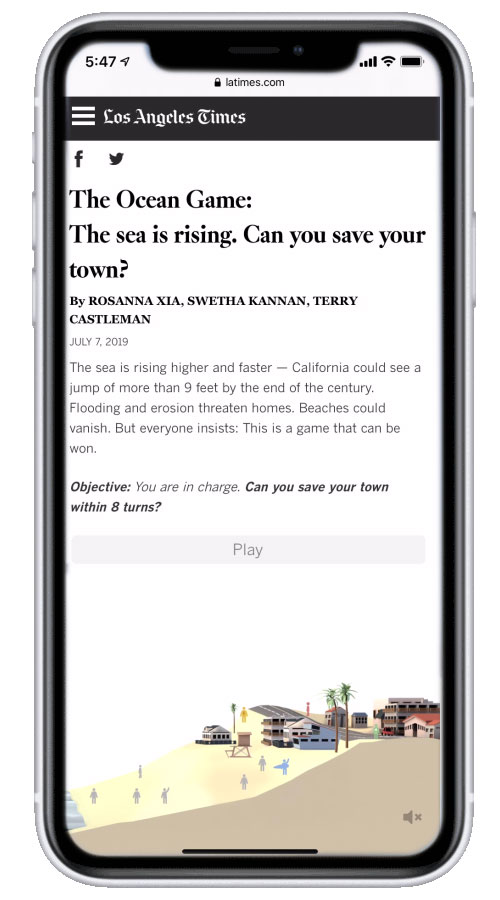Overview

- Design Lead & Front-end Developer
- Design Lead, Reporter, Developer (myself and one other)
- 2018 - 2019
- Los Angeles Times
- Reporting
Game Design
Hi-fi Mock-up
Mid-fi Mock-up
Product Management

This was the second in a 2-part investigation into the California coastline. The story was in production for more than a year and published late 2019.
We were tasked with creating a news game that explains why coastal communities dealing with rising sea levels cannot easily address the problem.
The game put players in the shoes of power and had them try moving residents away from the coastline. Though this, the user can develop empathy for coastal communities.
Rosanna Xia, a reporter at the Los Angeles Times, was introduced to this problem space through her beat as an environmental reporter. Rosanna conducted interviews a variety of environmentalists, beach-goers, homeowners who had beachside properties and more. Together, her and Editor, Ben Muessig, created a concept map about what they felt a newsgame could be.

Diagrams show initial mockups of how game could progress (Swetha Kannan, Rosanna Xia / Los Angeles Times)

The Uber Game by the Financial Times was a huge inspiration for us.
Meanwhile, Terry Castleman and I also assessed the state of newsgames at the time by doing market research into the existing landscape. We found what worked and what did not and also observed what tools other newsrooms used to envoke empathy.
We wanted to show the primary stakeholders in this problem space - it is not just the home owners who are affected but also goverment workers, scientists, and everyday beach-goers.
We also wanted to show how difficult it is to convince actual homeowners to leave their property, even with a sizable financial incentive.
Finally, we wanted to demonstrate just how hairy this process is. It’s not an easy solution, even though scientist insist that it’s the only one.
The visuals needed to be aesthetic, easy to implement and load, and representative of the Times' brand identity.
The game needed to perform well on all platforms, since over 40% of the Times' audience at the time used mobile devices to access the site.
The Los Angeles Times has an aging audience that needed to play the game with minimal tutorials.
A big part of this problem space was how average homeowners are resistant to moving inland despite that being the only sane option. This nuance had to be shown in the game.
When designing the game we had to be factual while also relating the struggles of people involved in the situation. Above all, we wanted the audience to develop some empathy for the problem.
The game had to show what beachgoers feel about the issue and how that differs from environmentalists, politicians,homeowners, and others involved in the problem space.

Mid-fi mockup (Swetha Kannan / Los Angeles Times)
We playtested the game, using a text-only version created using twine.js, with 5 users.
Rosanna also sent the test game to her sources who gave us expert insight into how accurately the game portrays the problem space.
I used Cinema 4D to make all the 3D elements you see in the game and then used After Effects to create all the animations. Afterwards, I exported these animations used in the game into Javascript by using the the Bodymovin library.
A large part of this project was all the animations that I created for the game. Below are a select few.

The story published alongside it’s written version on July 7th, 2019.
The page published to great success. It was met with steady and increasing traffic for a week, a time frame almost unheard of in a fast-paced news cycle, and was one of our top viewed project pages of the year. Beyond the initial publishing week, the game has been used by professionals to teach students about the complexities of our beaches and to train local city officials before they began their duties assisting the development of beachside neighborhoods.
2020 Online Journalism Award, Finalist
2019 California Online Journalism Awards, 3rd place in Public Service Journalism
2019 California Online Journalism Awards, 2nd place in In-depth reporting